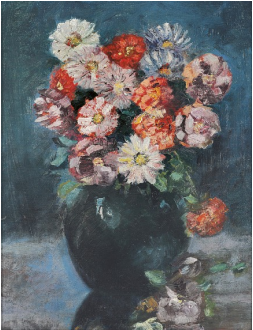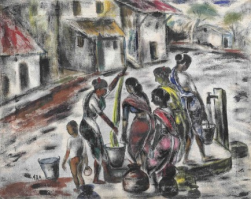Biography
Still life as a genre of painting in India was to come into its own with Krishnaji Howlaji Ara. While artists
like Souza and Raza had made forays into this form, it was only with Ara that there was a consistent
preoccupation with its meter and substance. The most intuitive of the modernists, he, at the same time, used
classical devices to extend the language of paint. Ara’s ceaseless experiments with bowls, fruits and vases with
flowers were to develop a compositional syntax to which he lent a rugged buoyancy and an unremitting
compassion. His singular achievement lay in coalescing these elements into a distinctive style, which made
quite an impact on the period. Ara’s early works were based on human situations, which he turned into
compositions much in the manner of textbook life studies. These were generic studies of fishing trawlers,
men and women at wedding receptions, and horse-riders, akin to the academic style taught in art schools and
reminiscent of turn-of-the-century painters like Dhurandhar and Abalal Rahiman. In many ways, Ara’s lack of
formal training could be seen as an advantage, for in his struggle for articulation there were no academic
impositions. As eclectic and raw as his painterly forms were, they were at the same time authentic to his inner
striving and were later to be turned to a stunning advantage. Even at this stage, however, what could be
evidenced was a penchant for compositions that drew from the quick of life, the raw edge as it were.


Ara made an astonishing entry into the art world, something that could only have been achieved by his
individual personality and in the formative period of Indian art in the 1940s. The son of a bus driver in
Bolarum near Secunderabad, Ara was born in 1914. He lost his mother at the age of three, and when his
father remarried he had to go through many unhappy days. In 1921, when he was seven, he ran away to
Bombay and was engaged as a domestic servant by a European woman. On discovering that he could paint,
she bought him water-colours and encouraged him. He still continued to serve as a domestic help and in
1930, while working for an Englishman C.C. Gullielan, he took part in Gandhi’s salt satyagraha. He was
arrested and jailed for five months, but Gullielan had him released. Free but jobless, he was taken in by a
friend - a chauffeur with a Japanese firm, the Yokohama Corporation. There he would wash cars for Rs 18 a
month, and then would paint in his spare time. In the aftermath of the bombing of Pearl Harbour, the
Japanese owner of the firm disappeared overnight. Ara took over the responsibility of looking after the house
and guarded his employer’s interests for years. Meanwhile, he continued to live in the servants’ quarters, a 10
x 10 ft. room at Walkeshwar, which was to double as his studio for the rest of his life. It was Rudi von Leyden, however, who not only detected the earliest signs
of talent in the young artist, but was also to become his
staunchest supporter. As Ara was jobless, Leyden offered
him a small stipend and took care of all his expenses so that
he could devote himself entirely to painting. In 1942, Ara
had his first one-man show at the Chetana Restaurant at
Rampart Row, organized by Kekoo Gandhi and
inaugurated by Raja Rao, then a struggling writer. The
show was a sell-out at a profit of Rs. 2,000, a princely sum
of him, and he took the money to Leyden to pay off his
debt. Leyden promptly refused to accept it and told Ara
that he was now on his own as a painter.
It cannot be said with certainty when Ara turned towards
painting still life, but it was around the late 1940s and all
through the 1950s that he continued to make varied
substantive studies of objects. It is possible that his
association with the Progressive Artists Group heightened
his innate modernism and stimulated him into turning
towards the classic preoccupations of the painterly image.
A deliberate roughness in both drawing and applying paint
is the most striking aspect of his still life paintings. The
hallmark of Ara’s still life works was the astonishing effect
he created in white. The colour which in itself is artificial as
it is not found in nature, was used by him to mould form.
In a composition with a jug, a bowl of grapes, and a plate
of apples, the white—thickly-layered and with the colours
showing through—overflows one from the other making
them part of the canvas and yet distinct from it. Ara’s
achievement lay in fusing a raw sensuality with a calculated
structuring, thereby revitalizing the entire still life genre. He constantly experimented with paint to acquire
what he describes as the ‘honest expression of form’. There is a rough, uneven, jagged look to all his still life
paintings, with minimal attention to details, which distinguishes his work from others. He painted mostly in
water-colour but he evolved his own technique by which he made it it look like an oil painting. This he
achieved by applying his colours straight from the tube and then spreading it in a dry impasto method.
Essentially a colourist, his device of using white was entirely original and full-bodied, allowing him to mould
his surface into infinite recesses.
Having experienced life from the underside, Ara was an innate humanist and was known to help many young
artists in need of organizing their shows, sending out invitations, and visiting newspaper offices. The most
enduring quality that remained with him was his compassion for others, which manifested itself in small acts
of kindness. On his fiftieth birthday in 1965, paintings from all periods of his life were exhibited and Ara
insisted in their price being a uniform Rs 100. This was at a time when his work could be sold at almost ten
times the value. Needless to say, all the paintings were sold. Towards his later years, Ara had begun to make
paintings that repeated themselves, emulating his earlier work. A considerable amount of his time was spent
looking after the activities of the Artist’s Centre, of which he was the secretary. He also devoted himself to
bringing up his adopted daughter Ruksana. At the time when Ara was climbing the ladder of success in the
1950s, he consulted a lawyer, Hyder Pathan, to help him with some documents before leaving for Europe.
Somewhat in awe of the well-known artist, Pathan persuaded him to teach his wife, Zainab, an aspiring
painter. As the friendship deepened, Ara became a frequent visitor to the house. A few years later, when their
daughter Ruksana was born, she was brought up more by Ara than by her own parents.
Ara’s death on June 30, 1985 was as poignant as his life. Since Ruksana was born, he would visit the Pathans
every evening and have dinner with them, after which he would leave for his tiny room in Walkeshwar. No
matter how late it would get, he would go by bus even if he could get a lift, he would refuse it. But in his final
week, he started staying overnight with the Pathans without any persuasion. On his last night, he slept on the
floor to straighten his back. He rose early, dressed himself, and died on the chair, quietly.
Text Reference:
Excerpts from the book The Making of Modern Indian Art: The Progressives by Yashodara Dalmia published
by Oxford University Press, New Delhi in 2001